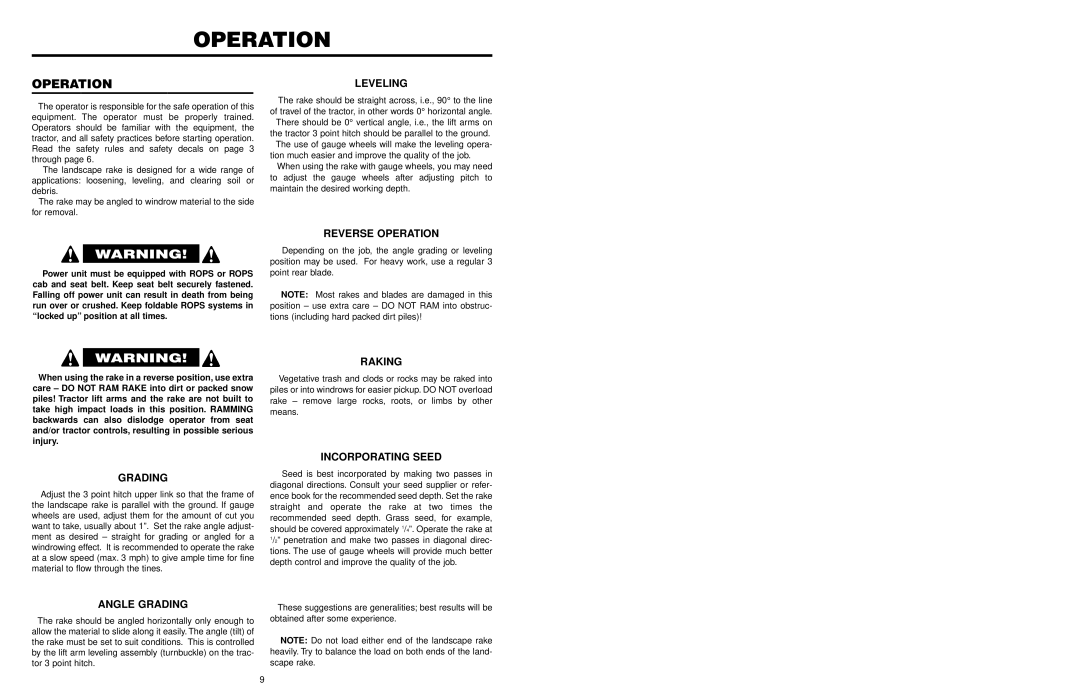
OPERATION
OPERATION
The operator is responsible for the safe operation of this equipment. The operator must be properly trained. Operators should be familiar with the equipment, the tractor, and all safety practices before starting operation. Read the safety rules and safety decals on page 3 through page 6.
The landscape rake is designed for a wide range of applications: loosening, leveling, and clearing soil or debris.
The rake may be angled to windrow material to the side for removal.
LEVELING
The rake should be straight across, i.e., 90° to the line of travel of the tractor, in other words 0° horizontal angle.
There should be 0° vertical angle, i.e., the lift arms on the tractor 3 point hitch should be parallel to the ground.
The use of gauge wheels will make the leveling opera- tion much easier and improve the quality of the job.
When using the rake with gauge wheels, you may need to adjust the gauge wheels after adjusting pitch to maintain the desired working depth.
WARNING!
Power unit must be equipped with ROPS or ROPS cab and seat belt. Keep seat belt securely fastened. Falling off power unit can result in death from being run over or crushed. Keep foldable ROPS systems in “locked up” position at all times.
REVERSE OPERATION
Depending on the job, the angle grading or leveling position may be used. For heavy work, use a regular 3 point rear blade.
NOTE: Most rakes and blades are damaged in this position – use extra care – DO NOT RAM into obstruc- tions (including hard packed dirt piles)!
WARNING!
When using the rake in a reverse position, use extra care – DO NOT RAM RAKE into dirt or packed snow piles! Tractor lift arms and the rake are not built to take high impact loads in this position. RAMMING backwards can also dislodge operator from seat and/or tractor controls, resulting in possible serious injury.
GRADING
Adjust the 3 point hitch upper link so that the frame of the landscape rake is parallel with the ground. If gauge wheels are used, adjust them for the amount of cut you want to take, usually about 1”. Set the rake angle adjust- ment as desired – straight for grading or angled for a windrowing effect. It is recommended to operate the rake at a slow speed (max. 3 mph) to give ample time for fine material to flow through the tines.
ANGLE GRADING
The rake should be angled horizontally only enough to allow the material to slide along it easily. The angle (tilt) of the rake must be set to suit conditions. This is controlled by the lift arm leveling assembly (turnbuckle) on the trac- tor 3 point hitch.
RAKING
Vegetative trash and clods or rocks may be raked into piles or into windrows for easier pickup. DO NOT overload rake – remove large rocks, roots, or limbs by other means.
INCORPORATING SEED
Seed is best incorporated by making two passes in diagonal directions. Consult your seed supplier or refer- ence book for the recommended seed depth. Set the rake straight and operate the rake at two times the recommended seed depth. Grass seed, for example, should be covered approximately 1/4”. Operate the rake at 1/2” penetration and make two passes in diagonal direc- tions. The use of gauge wheels will provide much better depth control and improve the quality of the job.
These suggestions are generalities; best results will be obtained after some experience.
NOTE: Do not load either end of the landscape rake heavily. Try to balance the load on both ends of the land- scape rake.
9
